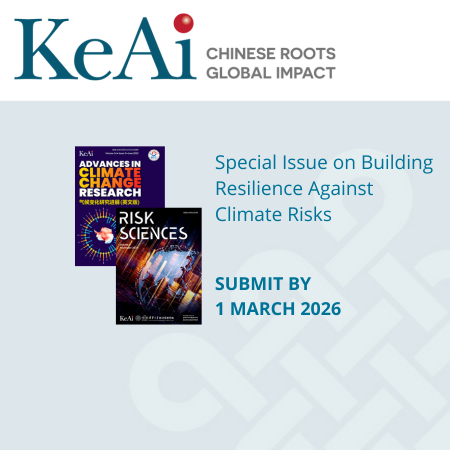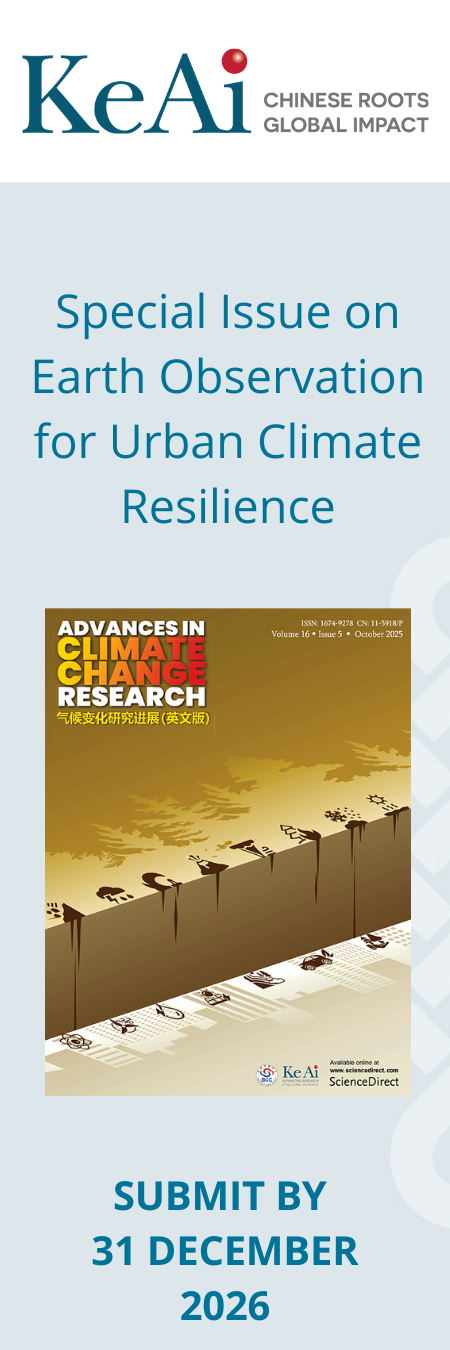Warming‒wetting and continentality co-modulate the effect of desertification on permafrost degradation on the Qinghai‒Xizang Plateau
December 2025
Permafrost degradation and desertification have been identified as two major land surface processes occurring on the Qinghai‒Xizang Plateau. However, the effect of desertification on permafrost degradation...
Contrasting trends of extreme rainfall and snowfall in the Northern Hemisphere
December 2025
Global warming has modified the distribution between solid and liquid precipitation, leading to changes in the intensity and frequency of extreme rainfall and snowfall. However, the distinct response...
Asymmetric response of Arctic sea ice and navigation to carbon emissions
December 2025
Arctic navigability has far-reaching socioeconomic consequences, but how the navigation will respond to negative carbon emissions proposed to mitigate global warming remains unclear. Based on the idealized...
Dynamics and drivers of China's crop production carbon emissions in 2001–2021: A micro‒macro data integration study
December 2025
China's crop production evolution has significantly reshaped spatial and temporal patterns of agricultural carbon emissions. However, a comprehensive understanding of the underlying driving mechanism...
A classification‒regression‒correction (CRC) strategy for precipitation merging with gauge-independent spatial autocorrelation predictors
December 2025
Multi-source precipitation merging enhances spatiotemporal estimation accuracy, yet machine learning (ML)-based methods suffer from limitations in rain/no-rain identification and violate ML principles...
Response of water cycle over drylands to a warming future
December 2025
The synergistic relationship among various hydrological elements within the water cycle remains unclear because existing studies have mainly focused on the response of a single water cycle element to...
More prolonged hot, dry, and compound dry‒hot events in China than expected based on observation-constrained projections
December 2025
Despite growing evidence of intensifying hot and dry extremes, future projections remain highly uncertain due to substantial inter-model discrepancies, particularly at regional scales. This study investigates...
Synergistic effects of warming and heavy snowfall accumulation on the increased risk of large-scale snow avalanches in the western Tianshan Mountains
December 2025
Climate change has increased temperatures and altered snowpack properties, which in turn affect avalanche activity. The extent to which climate change affects avalanche activity and how avalanche activity...
Impact of demographic changes on carbon emissions under a carbon-neutral pathway
December 2025
The existing carbon-neutral oriented climate change policy modeling studies hardly consider the multidimensional demographic factors, and lack scientific understanding of the comprehensive impact of...
Geographically-dependent coastal marine heatwaves: Insights from coastal seas around a semi-enclosed bay
December 2025
Coastal seas connecting the open ocean and land are highly impacted by local terrestrial weather and climate systems. However, there is a lack of research focus on the distinct coastal geographical...
Ground surface temperature variations and their links to permafrost distribution in the Genhe River Basin, Da Xing'anling Mountain Range
December 2025
Ground surface temperature (GST) fundamentally controls permafrost distribution in transitional zones, yet the link between GST variability and permafrost occurrence remains poorly understood, particularly...
The distinctive characteristics of glacier surface melt under the combined control of westerlies and monsoon in the northeastern Tibetan Plateau
December 2025
As a key part of the Asian Water Tower, the glaciers in the northeastern Tibetan Plateau (TP) experience the mass balance changes jointly regulated by the westerlies and monsoon circulation. However,...
Review of WRF for weather and climate change over the Tibetan Plateau
December 2025
The state-of-the-art Weather Research and Forecasting Model (WRF) is an indispensable tool for studying weather and climate change; however, its application over the Tibetan Plateau—a region characterized...
Climate change-induced northward shifts in double cropping system in China: Implications for crop production potential and water use
December 2025
Climate change may shift double cropping system into new areas and increase cropping intensity in some regions, creating opportunities to boost crop production. However, these changes also reshape the...
Escalating risks of anomalously hot–dry growing seasons in arid Northwest China under human influence
December 2025
The anomalous hydrothermal conditions during growing seasons, i.e. less precipitation and high temperature, could induce an unstable water resource supply and pose great threats to regional agro-pastoral...
Deceleration of tropopause rise amidst ozone recovery over Queen Maud Land, East Antarctica
December 2025
Tropopause height (H), a crucial variable for assessing upper-air climate change, is primarily modulated by temperature variations in the troposphere and stratosphere. While the recovery of Antarctic...
The tempo‒spatial heterogeneity of the association between hourly ambient temperature and injury morbidity: A nationwide large case-crossover study in China
December 2025
In the context of global warming, the impact on human health has received increasing attention. However, studies focusing on injury are limited, with most examining temperature-injury association on...
Modeling the 21st-century response of Greenland’s Zachariæ Isstrøm and Nioghalvfjerdsfjorden Glaciers to atmosphere‒ocean forcing and friction laws
Available online 2 December 2025
Recent rapid retreat of outlet glaciers in Northeast Greenland has raised concerns over their future stability and sea-level-rise potential. However, large uncertainties remain in long-term projections...
Expansion and outburst process of Aksu Kule Lake in the Kunlun Mountains, Qinghai‒Tibet Plateau
Available online 28 November 2025
Rapid lake expansion and sudden outburst events have emerged as critical hydrological phenomena on the Qinghai–Tibet Plateau (QTP), reshaping endorheic basins and threatening downstream ecosystems and...
Autumn snow expansion and spring divergence in Northeast China (2000–2020)
Available online 26 November 2025
Mid-latitude snow has broadly declined, but Northeast China (NEC) shows a seasonal divergence that remains insufficiently explained. We integrated a cloud-free 500 m MODIS snow-phenology record with...
Possible linkage between sudden stratospheric warmings and transboundary aerosol transport from South Asia to the Tibetan Plateau
Available online 19 November 2025
South Asian cross-border aerosols play a critical role in the climate change of the Tibetan Plateau (TP). While previous studies have investigated the transboundary transport of these aerosols primarily...
Study on the concept and framework of synergy between mitigation and adaptation
Available online 12 November 2025
Carbon neutrality and the Global Goal on Adaptation jointly drive the integration of mitigation and adaptation; however, a clear conceptual and analytical framework for their synergy remains absent....
Increasing extreme heat events in the permafrost region of the Northern Hemisphere
Available online 10 November 2025
The intensification of extreme heat events is a potent thermal disturbance that can trigger abrupt permafrost degradation. However, a systematic understanding of their spatiotemporal variation across...
Increasing coupling of hot‒dry winds and drought across China: Observational evidence and future projection
Available online 7 November 2025
Hot‒dry winds (HDW) and droughts are two prevailing climate hazards posing increasing threats to human societies and natural ecosystems. Insights into compound HDW and drought events (CHDWDs) fill gaps...
Contrasting biophysical impacts of vegetation growth and type transition greening on local temperature in Southwestern China
Available online 5 November 2025
There is a noticeable greening trend observed in China over the first two decades of the 21st century attributed to both vegetation growth and type transition. However, the comparative impacts of these...


